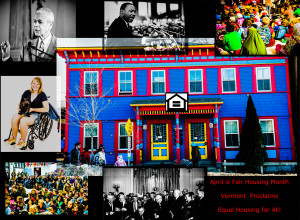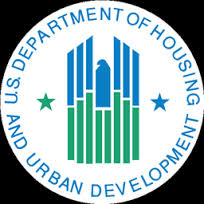Continue reading Economic Inequality Largely Boils Down to Housing Inequality – CityLab


 Getting a head start on April in March –
Getting a head start on April in March –Note: All the content below in this post is taken from a web site maintained by the U.S. Department of Housing and Urban Development.
is taken from a web site maintained by the U.S. Department of Housing and Urban Development.
In April, we come together as a community and a nation to celebrate the anniversary of the passing of the Fair Housing Act and recommit to that goal which inspired us in the aftermath of Rev. Dr. Martin Luther King Jr’s assassination in 1968: to eliminate housing discrimination and create equal opportunity in every community.
Fundamentally, fair housing means that every person can live free. This means that our communities are open and welcoming, free from housing discrimination and hostility. But this also means that each one of us, regardless of race, color, religion, national origin, sex, familial status, and disability, has access to neighborhoods of opportunity, where our children can attend quality schools, our environment allows us to be healthy, and [for us to grow] opportunities and self-sufficiency.
…commitment to fair housing is a living commitment, one that reflects the needs of America today and prepares us for a future of true integration.
On April 11, 1968, President Lyndon Johnson signed the Civil Rights Act of 1968, which was meant as a follow-up to the Civil Rights Act of 1964. The 1968 act expanded on previous acts and prohibited discrimination concerning the sale, rental, and financing of housing based on race, religion, national origin, sex, (and as amended) handicap and family status. Title VIII of the Act is also known as the Fair Housing Act (of 1968).
The enactment of the federal Fair Housing Act on April 11, 1968 came only after a long and difficult journey. From 1966-1967, Congress regularly considered the fair housing bill, but failed to garner a strong enough majority for its passage. However, when the Rev. Dr. Martin Luther King, Jr. was assassinated on April 4, 1968, President Lyndon Johnson utilized this national tragedy to urge for the bill’s speedy Congressional approval. Since the 1966 open housing marches in Chicago, Dr. King’s name had been closely associated with the fair housing legislation. President Johnson viewed the Act as a fitting memorial to the man’s life work, and wished to have the Act passed prior to Dr. King’s funeral in Atlanta.
Another significant issue during this time period was the growing casualty list from Vietnam. The deaths in Vietnam fell heaviest upon young, poor African-American and Hispanic infantrymen. However, on the home front, these men’s families could not purchase or rent homes in certain residential developments on account of their race or national origin. Specialized organizations like the NAACP, the GI Forum and the National Committee Against Discrimination In Housing lobbied hard for the Senate to pass the Fair Housing Act and remedy this inequity. Senators Edward Brooke and Edward Kennedy of Massachusetts argued deeply for the passage of this legislation. In particular, Senator Brooke, the first African-American ever to be elected to the Senate by popular vote, spoke personally of his return from World War II and inability to provide a home of his choice for his new family because of his race.
With the cities rioting after Dr. King’s assassination, and destruction mounting in every part of the United States, the words of President Johnson and Congressional leaders rang the Bell of Reason for the House of Representatives, who subsequently passed the Fair Housing Act. Without debate, the Senate followed the House in its passage of the Act, which President Johnson then signed into law.
The power to appoint the first officials administering the Act fell upon President Johnson’s successor, Richard Nixon. President Nixon tapped then Governor of Michigan, George Romney, for the post of Secretary of Housing and Urban Development. While serving as Governor, Secretary Romney had successfully campaigned for ratification of a state constitutional provision that prohibited discrimination in housing. President Nixon also appointed Samuel Simmons as the first Assistant Secretary for Equal Housing Opportunity.
When April 1969 arrived, HUD could not wait to celebrate the Act’s 1st Anniversary. Within that inaugural year, HUD completed the Title VIII Field Operations Handbook, and instituted a formalized complaint process. In truly festive fashion, HUD hosted a gala event in the Grand Ballroom of New York’s Plaza Hotel. From across the nation, advocates and politicians shared in this marvelous evening, including one of the organizations that started it all — the National Committee Against Discrimination In Housing.
In subsequent years, the tradition of celebrating Fair Housing Month grew larger and larger. Governors began to issue proclamations that designated April as “Fair Housing Month,” and schools across the country sponsored poster and essay contests that focused upon fair housing issues. Regional winners from these contests often enjoyed trips to Washington, DC for events with HUD and their Congressional representatives.
Under former Secretaries James T. Lynn and Carla Hills, with the cooperation of the National Association of Homebuilders, National Association of Realtors, and the American Advertising Council these groups adopted fair housing as their theme and provided “free” billboard space throughout the nation. These large 20-foot by 14-foot billboards placed the fair housing message in neighborhoods, industrial centers, agrarian regions and urban cores. Every region also had its own celebrations, meetings, dinners, contests and radio-television shows that featured HUD, state and private fair housing experts and officials. These celebrations continue the spirit behind the original passage of the Act, and are remembered fondly by those who were there from the beginning.
U.S. Department of Housing and Urban Development
This is the last grant-funded post, so we’ll try to keep it snappy, not sappy. What do we know about housing, anyway? Not a lot, but a good deal more than when we signed on to this gig 10 months ago.
For what they’re worth, we’ll leave you with a gratuitous thought and an anti-climactic ranking.
Housing can’t simply be left to the private market, any more than health care or education. It’s time for people to accept that resolving the housing-affordability crisis will require significant new governmental investment; and alleviating the socioeconomic and racial segregation that continue to stand in the way of fair housing choice, all across the country, will require concerted government intervention. Why shouldn’t the right to decent housing and fair housing choice be a public policy priority commensurate with the right to health care or the right to receive an education?
Rankings abound at New Year, so here’s one with an ancillary question: Rent or buy? 504 counties around the country are listed in order of rental affordability — that is, the percentage of local median income that’s required to pay median rent of three-bedroom apartment in that county. Also listed is the affordability percentage of a median priced home. Compare the percentages to see whether it’s more affordable to rent or buy.
No. 1 in rental affordability (or unaffordability) is Honolulu, at 73 percent. Buy. No. 505 is Huntsville, Ala., at 23 percent. Buy.
You can get to the Excel table by clicking here.
The only Vermont county in the table is Chittenden (listed as Burlington/South Burlington). Sorry, Bellows Falls, Bennington, et al, but that’s the way of these national surveys.
Burlington/South Burlington comes in at No. 152 in rental affordability, at 40 percent. Buying affordability: 46 percent. The recommendation: Rent.

That’s despite the fact that, according to the table, the cost of a 3 BR apartment in Burlington/South Burlington went up 12.2 percent in the last year.
Sounds a little high to us (so much for the 3.3 percent figure we’ve been hearing) but again, what do we know?
Could be worse.
A key goal of affirmatively furthering fair housing (AFFH), as it’s envisioned playing out around the country, is to break up concentrations of poverty and to promote socioeconomic and racial integration. That means ensuring opportunities for lower-income people and racial minorities to live in wealthier, “high opportunity” neighborhoods with access to jobs, goods schools and public services.
Two ways to facilitate those opportunities:
Both of these approaches deserve consideration around here, as Vermonters contemplate how to make their communities more socioeconomically inclusive. Meanwhile, it’s interesting to see how they’ve played out in an entirely different environment: metropolitan Baltimore.
First, some background: Baltimore has a long history of racial segregation (click here for a trenchant account), and in the mid-1990s, the Department of Housing and Urban Development was sued by city residents (Thompson vs. HUD) for its failure to eliminate segregation in public housing. In 2005, a federal judge found that HUD had violated the Fair Housing Act by maintaining existing patterns of impoverishment and segregation in the city and by failing to achieve “significant desegregation” in the Baltimore region.
Seven years later, a court-approved settlement resolved the case in a way that anticipated the AFFH rule that HUD issued this past summer.
The settlement called on HUD to continue the Baltimore Mobility Program, begun in 2003 in an earlier settlement phase. The program has provided housing vouchers to more than 2,600 families to move out of poor, segregated neighborhoods and into areas with populations that are less than 10 percent impoverished and less than 30 percent black. The program provides counseling before and after the move and has received high marks from evaluators who cite improved educational and employment outcomes for beneficiaries. A similar regional program is underway in Chicago.
The settlement also called for affordable-housing development in these “high-opportunity” suburban communities – 300 units a year through 2020. To make this happen, HUD was to provide new financial incentives for developers.
Here is where the story takes a dispiriting turn. Three years later, not a single developer has applied for the incentives. No affordable housing projects are even in the pipeline. That’s according to an eye-opening story the other day in the Baltimore Sun.
So, what happened? Why haven’t developers shown any interest? HUD had no explanation, according to the story, which suggested that perhaps the program hadn’t been well-enough publicized: a prominent builder of affordable housing admitted he didn’t even know about the incentives. Could it be that they weren’t generous enough?
Whatever the reason, the Baltimore experience reflects how difficult it can be to introduce affordable housing to privileged enclaves. No one should underestimate the AFFH challenge.
The Center for American Progress has put out a report that nicely ties together, in summary fashion, the current status of fair housing and unaffordable housing. These are the mainstay, overlapping concerns of the “Thriving Communities” campaign. If you’re looking for a fairly brief (33 pages) treatment of where things stand, complete with an array of federal policy recommendations, “An Opportunity Agenda for Renters” is worth a look. 
The report touches on many of the topics we’ve mentioned in this blog — the persistence of racial and socioeconomic segregation, the barriers to mobility from impoverished to high-opportunity areas, the growing financial burdens on the growing class of renters in the face of woefully insufficient public subsidies.
One of the policy recommendations, naturally, is that the primary federal vehicle for creating or preserving affordable housing be expanded. That’s the Low Income Housing Tax Credit, which accounts for about 110,000 residential units a year, according to the report. But even if that program were increased by 50 percent, as called for by the Bipartisan Policy Center’s Housing Commission, the total number of units created or preserved would still be way too few, considering “the current shortage of 4.5 million units that are affordable to extremely low-income households.”
As things stand, the federal tax code benefits homeowners in several ways, and disproportionately the wealthier ones. The mortgage-interest tax deduction alone costs the government about $70 billion a year. By contrast, increasing funding of the Section 8 program to cover 3 million eligible low-income renters who are shut out of the program now would cost just $22 billion.
Here’s another proposal in renters’ favor: creating a federal renters’ tax credit. A modest tax credit benefiting the lowest income renters could cost a mere $5 billion.
Vermont’s renter rebate is better than nothing, but it still doesn’t go very far. In 2012, according to a 2014 report to the Legislature, 13,541 claimants (about one-fifth of the state’s renting households) received a total of $8.7 million in rebates, for an average of $641. That $641 was not enough to unburden the typical claimant.
“On average,” the report stated, “Vermont’s renter rebate program reduces gross rent as a percent of household income from 36.7 percent to 33.6 percent.” 
In other words, the average renter was living in an unaffordable place even after the rebate.
It wasn’t the failure of “forced busing” that led to current racial disparities in school achievement outcomes. The problem, rather, is that the nation’s schools have become more segregated over the last three decades, as integration dropped from the agenda of education policy-makers.
So wrote a Syracuse University education professor, George Theoharis, in an interesting piece in the Washington Post Sunday. 
Two startling observations derive from his home town — which happens to be in our neck of the woods.
He notes the enormous disparities in programs, and outcomes, between a middle school with an 85 percent black and Latino student body and another middle school, 10 miles away, that’s 88 percent white. And he points out that in 1989, the city’s schools were about 60 percent white and 20 percent black/Latino, and that now, the district is 28 percent white, 55 percent black/Latino.
Theoharis goes on to discuss how a renewed emphasis on desegregation in educational policy could provide remedies: Redesigning school districts, for example, and putting them together “like pie pieces, so they cut across urban, suburban and even rural spaces”; or creating magnet schools; or providing incentives to school districts to desegregate.
(Note: Magnet schools were the Burlington School District’s remedy for socioeconomic achievement gaps.)
But Theoharis never delves into the heart of the matter: residential segregation. This has grown worse in many cities since 2000, with an increase in the number of high-poverty neighborhoods, as we noted in an earlier blog post citing “The Architecture of Segregation,” a paper that detailed the demographic trends. In Syracuse since 2000, according to that paper, “the number of high-poverty tracts more than doubled, rising from twelve to thirty… As a result, Syracuse now has the highest level of poverty concentration among blacks and Hispanics of the one hundred largest metropolitan areas,” as shown in this table:
The takeaway is that addressing residential segregation iskey to addressing school segregation. Another analysis of school segregation and racial performance disparities, by the Economic Policy Institute’s Richard Rothstein, put it like this:
“Education analysts frequently wonder why a black–white achievement gap remains, even when individual poverty and family characteristics are similar. Partly it’s because of greater (and multigenerational) segregation of black children into neighborhoods of high poverty, few employment opportunities, and frequent violence….
“It is inconceivable to think that education as a civil rights issue can be addressed without addressing residential segregation … Housing policy is school policy; equality of education relies upon eliminating the exclusionary zoning ordinances of white suburbs and subsidizing dispersed housing in those suburbs for low-income African Americans now trapped in central cities.”
That’s what affirmatively furthering fair housing is all about, right? But you already knew that.
The Democratic presidential candidates had a fair amount to say last night about the disappearing middle class, but not about where all of those fallen people can afford to live. Housing unaffordability is a “crisis” throughout the country, judging from news accounts, but it was not among the “pressing issues” deemed worthy of discussion in the debate.
One likely reason is that “pressing issues” for the purpose of this debate were defined, in part, by the volume of traffic they generate on Facebook. Perhaps housing advocates need to devote themselves more devoutly to social media.
Another reason, as we’ve suggested in previous posts, is that any substantial solution to the affordability problem will require major federal investments, in the form of subsidies, public housing and so forth. To be sure, raising wages – as the candidates pledged to do – will help alleviate the problem, but even a minimum wage of $15 will leave millions of people house-poor.
Here’s an idea that might have been introduced during the debate’s back-and-forths about capitalism, but wasn’t: Housing, like education and health care, is basic human need that requires major governmental intervention and that can’t simply be left to market forces. Don’t take our word for it –check out what an establishmentarian magazine, The Economist, has to say about housing as one of capitalism’s unmet challenges.
Another housing topic the candidates bypassed was the pronounced racial segregation that still marks residential settlement patterns in metropolitan areas all over the country, 47 years after the passage of a Fair Housing Act that was intended to undo that segregation.
They had opportunities to discuss this, when they were invited to talk about “issues of race in America” or the unrest in Baltimore, but the focus remained on reforming the criminal justice system, improving educational opportunities, and so forth. Not that these aren’t important, but there’s another perspective on the events of Baltimore and Ferguson that deserves attention. Consider this analysis by the Economic Policy Institute’s Richard Rothstein, published soon after the Baltimore riots:
“Whenever young black men riot in response to police brutality or murder, as they have done in Baltimore this week, we’re tempted to think we can address the problem by improving police quality—training officers not to use excessive force, implementing community policing, encouraging police to be more sensitive, prohibiting racial profiling, and so on. These are all good, necessary, and important things to do. But such proposals ignore the obvious reality that the protests are not really (or primarily) about policing.
“Baltimore, not at all uniquely, has experienced a century of public policy designed, consciously so, to segregate and impoverish its black population. A legacy of these policies is the rioting we have seen ….Whether after the 1967 wave of riots that led to the Kerner Commission report, after the 1992 Los Angeles riot that followed the acquittal of police officers who beat Rodney King, or after the recent wave of confrontations and vandalism following police killings of black men, community leaders typically say, properly, that violence isn’t the answer and that after peace is restored, we can deal with the underlying problems. We never do so.
“Certainly, African American citizens of Baltimore were provoked by aggressive, hostile, even murderous policing, but … (w)ithout suburban integration, something barely on today’s public policy agenda, ghetto conditions will persist, giving rise to aggressive policing and the riots that inevitably ensue. Like Ferguson before it, Baltimore will not be the last such conflagration the nation needlessly experiences.”
“Forty families on one lot, using one water faucet. Living in barren one room huts, they were deprived of the glory of sunshine in the daytime, and were so poor they could not even at night use the electricity that is to be generated by our great river…
“I found one family that might almost be called typical. Living within one dreary room, where no single window let in the beneficent sunlight, and where not even the smallest vagrant breeze brought them relief in the hot summer – here they slept, here they cooked and ate, here they washed themselves in a leaky tin tub after carrying the water for 100 yards. Here they brought up their children ill-nourished and amid sordid surroundings…”
The speaker was Congressman Lyndon B. Johnson, in his home district of Austin, describing the “slum tarnish” he observed during a Christmas Day walk through town. He made his remarks in a radio address to his constituents (this was well before LBJ himself got into the radio business), hoping to win their support for something new in town: public housing. The address became known as his “Tarnish” speech.
Here’s a photo (albeit not from Texas) that seems to capture what he was talking about:
Thirty years before he orchestrated the passage of the Fair Housing Act as president, Johnson – whose ambition as a young congressman is captured by this 1937 photo of him shortly after his election, with FDR in Galveston – prevailed in that housing campaign.
The first public housing in the country built under the 1937 housing act was in Austin. It was segregated, like most public housing that sprang up around the country over the next few decades, but less sordid than what they replaced. LBJ used that word – sordid – to good effect at HUD’s inauguration, when he declared: “Our cities and our new urban age must not be symbols of a sordid society.”
“Sordid” might be an apt description for some blocks of big-city, high-rise public housing, thoroughly segregated, underfunded and bereft of hope, if not sunlight. High rises came into planners’ favor in the ‘40s, but a couple of decades later they were not. For a tidy history of public housing, click here.
Some argue that public housing outside the big inner cities has worked quite well, and perhaps that can be said for places like Vermont, which apparently got into public housing fairly late in the game. (Burlington’s housing authority dates from 1961, and the state’s, from 1968.) If a history of Vermont’s public housing hasn’t been written, it’s a thesis topic in waiting.
Affirmatively furthering fair housing (AFFH) is a recurrent theme on this website, so if you’re still not conversant with the phrase, today’s post is another opportunity. Essentially, the AFFH rule issued by HUD over the summer represents a reinvigorated push to promote inclusive communities and to break up concentrated areas of segregation and poverty that the 1968 Fair Housing Act was intended to dispel.
If for no other reason, you should become familiar with AFFH because it’s a key addition to contemporary American civil rights vocabulary. You can bone up on previous posts here, or here, or delve in to some of this website’s Resources.
And if you’re a citizen committed to supporting affordable housing development in mixed-income, higher opportunity areas, your role may be important than you thought. Consider this excerpt from an essay by Michael Allen, a partner in the civil rights law firm of Relman, Dane & Colfax and one of the leading legal lights nationally in fair housing litigation:
“What HUD produced is a Final Rule long on ‘carrots,’ but painfully short on ‘sticks.’ To compound that problem, HUD does not currently have—and is very unlikely to acquire—sufficient resources to police the compliance of 1200 block grant recipients and 3400 public housing agencies. As a consequence, the promise of the Affirmatively Furthering Fair Housing (AFFH) mandate is likely to be realized only in communities where grassroots and legal advocates mobilize and create their own enforcement strategies. The success of the Final Rule will depend on this grassroots mobilization, on a community-by-community basis, all over the country. That means advocates, collectively, need to step up to the plate and provide the tools and resources for a sustained ‘ground game.’”
As for “carrots” that municipalities can offer for affordable housing development, the Fair Housing Project’s own Ted Wimpey offered a nice summation in his August testimony to the Vermont Advisory Committee to the U.S. Commission on Civil Rights: inclusionary zoning, density bonuses and impact-fee reductions, among others.
Elizabeth Warren, the Massachusetts senator, gave a speech Sunday in Boston that the website “Salon” called “the realest talk on race by any American politician.” She delivered her remarks at the Edward M. Kennedy Institute for the United States Senate as part of a “Getting to the Point” lecture series.
She had something to say about violence, about voting, and about economic justice – and economic justice as it relates to housing. Some excerpts:
“For most middle class families in America, buying a home is the number one way to build wealth. It’s a retirement plan-pay off the house and live on Social Security. An investment option-mortgage the house to start a business. It’s a way to help the kids get through college, a safety net if someone gets really sick, and, if all goes well and Grandma and Grandpa can hang on to the house until they die, it’s a way to give the next generation a boost-extra money to move the family up the ladder.
“For much of the 20th Century, that’s how it worked for generation after generation of white Americans – but not black Americans. Entire legal structures were created to prevent African Americans from building economic security through home ownership. Legally-enforced segregation. Restrictive deeds. Redlining. Land contracts. Coming out of the Great Depression, America built a middle class, but systematic discrimination kept most African-American families from being part of it.
“State-sanctioned discrimination wasn’t limited to homeownership. The government enforced discrimination in public accommodations, discrimination in schools, discrimination in credit-it was a long and spiteful list.”
Here we interject that she’s just scratching the surface of the federal government’s tawdry history of promoting residential segregation by race. For an eye-opening summation, check out what Richard Rothstein, of the Economic Policy Institute, had to say at the recent HUD conference in Washington. See the video we posted previously.
We note also the racial disparity in home ownership. In 2010, in Vermont, according to the 2012 “Analysis of Impediments to Fair Housing Choice,” the home-ownership for whites (71.4 percent) was nearly twice that for blacks (32.5 percent).
Warren went on to talk inequality over the last few decades, including the disparate effects of predatory lending that preceded the housing crash:
“Research shows that the legal changes in the civil rights era created new employment and housing opportunities. In the 1960s and the 1970s, African-American men and women began to close the wage gap with white workers, giving millions of black families hope that they might build real wealth.
“But then, Republicans’ trickle-down economic theory arrived. Just as this country was taking the first steps toward economic justice, the Republicans pushed a theory that meant helping the richest people and the most powerful corporations get richer and more powerful. I’ll just do one statistic on this: From 1980 to 2012, GDP continued to rise, but how much of the income growth went to the 90% of America – everyone outside the top 10% – black, white, Latino? None. Zero. Nothing. 100% of all the new income produced in this country over the past 30 years has gone to the top ten percent.
“Today, 90% of Americans see no real wage growth. For African-Americans, who were so far behind earlier in the 20th Century, this means that since the 1980s they have been hit particularly hard. In January of this year, African-American unemployment was 10.3% – more than twice the rate of white unemployment. And, after beginning to make progress during the civil rights era to close the wealth gap between black and white families, in the 1980s the wealth gap exploded, so that from 1984 to 2009, the wealth gap between black and white families tripled.
“The 2008 housing collapse destroyed trillions in family wealth across the country, but the crash hit African-Americans like a punch in the gut. Because middle class black families’ wealth was disproportionately tied up in homeownership and not other forms of savings, these families were hit harder by the housing collapse. But they also got hit harder because of discriminatory lending practices-yes, discriminatory lending practices in the 21st Century. Recently several big banks and other mortgage lenders paid hundreds of millions in fines, admitting that they illegally steered black and Latino borrowers into more expensive mortgages than white borrowers who had similar credit. Tom Perez, who at the time was the Assistant Attorney General for Civil Rights, called it a “racial surtax.” And it’s still happening – earlier this month, the National Fair Housing alliance filed a discrimination complaint against real estate agents in Mississippi after an investigation showed those agents consistently steering white buyers away from interracial neighborhoods and black buyers away from affluent ones. Another investigation showed similar results across our nation’s cities. Housing discrimination alive and well in 2015.”